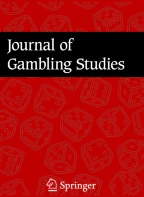Two studies sought to determine whether perceived control has different effects on confidence assessment and betting decisions among pathological and problem gamblers than among non-problem gamblers. In Study 1, 200 college students who were frequent gamblers (80 female and 120 male, median age 20) completed the South Oaks Gambling Screen (SOGS) and then engaged in a task in which they answered questions, assessed confidence in each answer, and considered bets on their answers that were fair if they were well-calibrated, but unfavorable if they were overconfident. Probable pathological and problem gamblers earned significantly fewer points than non-problem gamblers. This was due to greater overconfidence among pathological and problem gamblers, which led to systematically less favorable bets. In Study 2, using 384 participants (105 female and 279 male, median age 20), control was independently manipulated and bets were constructed to make point value independent of overconfidence. Problem and pathological gamblers showed both greater overconfidence and greater bet acceptance. They were less affected by control in their betting decisions than non-problem gamblers, but more affected in the slope of their betting function. It is concluded that pathological and problem gamblers process information about confidence and control differently from non-problem gamblers.
Similar content being viewed by others
References
R. B. Breen M. L. Frank (1993) ArticleTitleThe effects of statistical fluctuations and perceived status of a competitor on the illusion of control in experienced gamblers Journal of Gambling Studies 9 265–276 Occurrence Handle10.1007/BF01015922
W. K. Campbell A. S. Goodie J. D. Foster (2004) ArticleTitleNarcissism, confidence and risk attitude Journal of Behavioral Decision Making 17 297–311 Occurrence Handle10.1002/bdm.475
M. G. Dickerson (1993) ArticleTitleInternal and external determinants of persistent gambling: Problems in generalising from one form of gambling to another Journal of Gambling Studies 9 225–245 Occurrence Handle10.1007/BF01015920
M. Dickerson S. Adcock (1987) ArticleTitleMood, arousal and cognitions in persistent gambling: Preliminary investigation of a theoretical model Journal of Gambling Behavior 3 3–15
M. Dickerson M. Walker S. L. England J. Hinchy (1990) ArticleTitleDemographic, personality, cognitive and behavioral correlates of off-course betting involvement Journal of Gambling Studies 6 165–182
M. L. Frank C. Smith (1989) ArticleTitleIllusion of control and gambling in children Journal of Gambling Behavior 5 127–136 Occurrence Handle10.1007/BF01019759
R. Gonzalez G. Wu (1999) ArticleTitleOn the shape of the probability weighting function Cognitive Psychology 38 129–166 Occurrence Handle10.1006/cogp.1998.0710
A. S. Goodie (2003) ArticleTitleThe effects of control on betting: Paradoxical betting on items of high confidence with low value Journal of Experimental Psychology: Learning, Memory, and Cognition 29 598–610 Occurrence Handle10.1037/0278-7393.29.4.598
M. D. Griffiths (1990) ArticleTitleThe cognitive psychology of gambling Journal of Gambling Studies 6 31–42
D. Kahneman A. Tversky (1982) ArticleTitleThe psychology of preferences Scientific American 248 160–173
H.- L. Kroeber (1992) ArticleTitleRoulette gamblers and gamblers at electronic game machines: Where are the differences? Journal of Gambling Studies 8 79–92 Occurrence Handle10.1007/BF01881470
R. Kweitel F. C. L. Allen (1998) ArticleTitleCognitive processes associated with gambling behaviour Psychological Reports 82 147–153 Occurrence Handle10.2466/PR0.82.1.147-153
R. Ladouceur A. Gaboury (1988) ArticleTitleEffects of limited and unlimited stakes on gambling behavior Journal of Gambling Behavior 4 119–126
R. Ladouceur A. Gaboury A. Bujold N. Lachance et al. (1991) ArticleTitleEcological validity of laboratory studies of videopoker gaming Journal of Gambling Studies 7 109–116 Occurrence Handle10.1007/BF01014526
R. Ladouceur A. Gaboury M. Dumont P. Rochette (1988) ArticleTitleGambling: Relationship between the frequency of wins and irrational thinking Journal of Psychology 122 IssueID4 409–414
R. Ladouceur C. Sylvain H. Letarte I. Giroux C. Jacques (1998) ArticleTitleCognitive treatment of pathological gamblers Behaviour Research & Therapy 36 1111–1119
R. Ladouceur M. Walker E. Becona (1998) ArticleTitleAproximacion cognitiva para la comprension y tratamiento del juego patologico. [A cognitive approach to the understanding and treatment of pathological gambling] Psicologia Contemporanea 5 56–71
E. J. Langer (1975) ArticleTitleThe illusion of control Journal of Personality and Social Psychology 32 311–328
H. R. Lesieur S. B. Blume (1987) ArticleTitleThe South Oaks Gambling Screen (SOGS): A new instrument for the identification of pathological gamblers American Journal of Psychiatry 144 1184–1188
S. M. Moore K. Ohtsuka (1997) ArticleTitleGambling activities of young Australians: Developing a model of behaviour Journal of Gambling Studies 13 207–236 Occurrence Handle10.1023/A:1024979232287
S. M. Moore K. Ohtsuka (1999) ArticleTitleBeliefs about control over gambling among young people, and their relation to problem gambling Psychology of Addictive Behaviors 13 339–347 Occurrence Handle10.1037/0893-164X.13.4.339
R. J. Rosenthal (1986) ArticleTitleThe pathological gambler’s system for self-deception Journal of Gambling Behavior 2 108–120 Occurrence Handle10.1007/BF01019629
J. Selzer (1992) ArticleTitleBorderline omnipotence in pathological gambling Archives of Psychiatric Nursing 6 215–218 Occurrence Handle10.1016/0883-9417(92)90062-N
Z. Steel A. Blaszczynski (1998) ArticleTitleImpulsivity, personality disorders and pathological gambling severity Addiction 93 895–905 Occurrence Handle10.1046/j.1360-0443.1998.93689511.x
C. Sylvain R. Ladouceur J. -M. Boisvert (1997) ArticleTitleCognitive and behavioral treatment of pathological gambling: A controlled study Journal of Consulting & Clinical Psychology 65 727–732 Occurrence Handle10.1037/0022-006X.65.5.727
T. Toneatto (1999) ArticleTitleCognitive psychopathology of problem gambling Substance Use & Misuse 34 1593–1604 Occurrence Handle10.3109/10826089909039417
T. Toneatto T. Blitz-Miller K. Calderwood R. Dragonetti A. Tsanos (1997) ArticleTitleCognitive distortions in heavy gambling Journal of Gambling Studies 13 253–266 Occurrence Handle10.1023/A:1024983300428
K. C. Winters P. Bengston D. Dorr R. Stinchfield (1998) ArticleTitlePrevalence and risk factors of problem gambling among college students Psychology of Addictive Behaviors 12 127–135 Occurrence Handle10.1037/0893-164X.12.2.127
K. C. Winters S. Specker R. S. Stinchfield (2002) Measuring pathological gambling with the Diagnostic Interview for Gambling Severity (DIGS) J. J. Marotta J. A. Cornelius W. R. Eadington (Eds) The downside: Problem and pathological gambling University of Nevada Reno, Nevada 143–148
Author information
Authors and Affiliations
Corresponding author
Rights and permissions
About this article
Cite this article
Goodie, A.S. The Role of Perceived Control and Overconfidence in Pathological Gambling. J Gambl Stud 21, 481–502 (2005). https://doi.org/10.1007/s10899-005-5559-1
Issue Date:
DOI: https://doi.org/10.1007/s10899-005-5559-1
